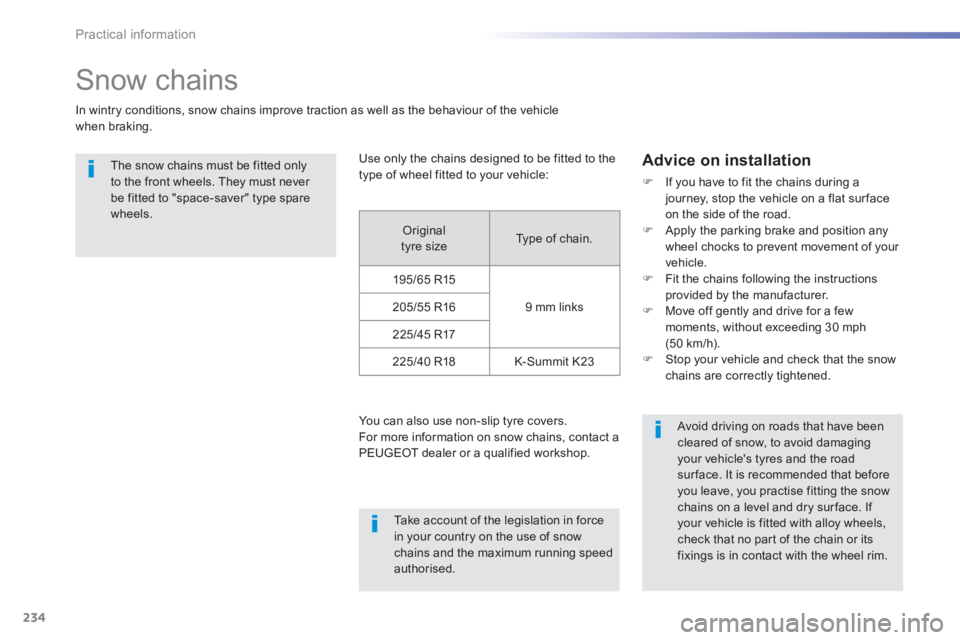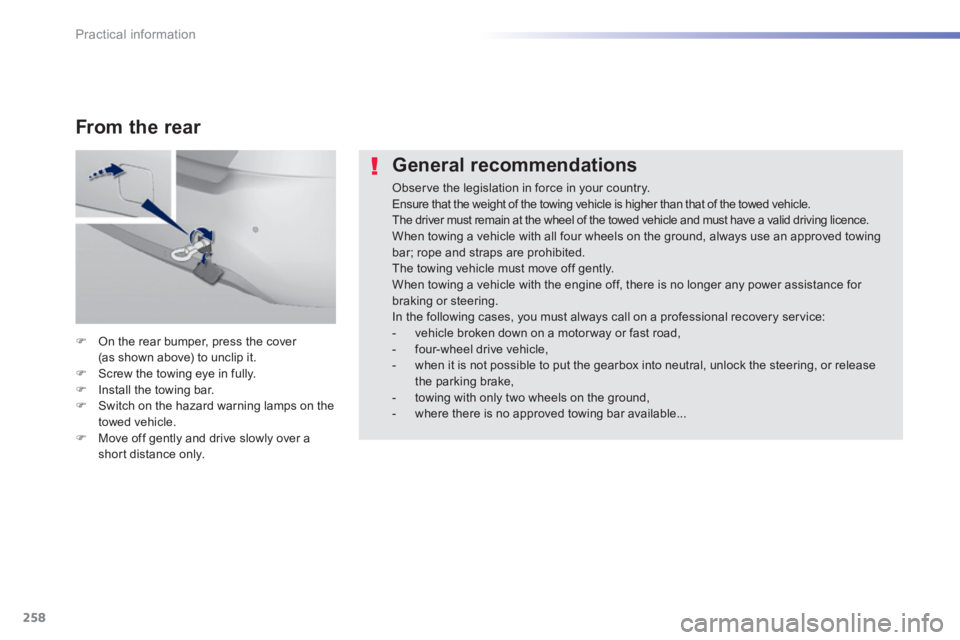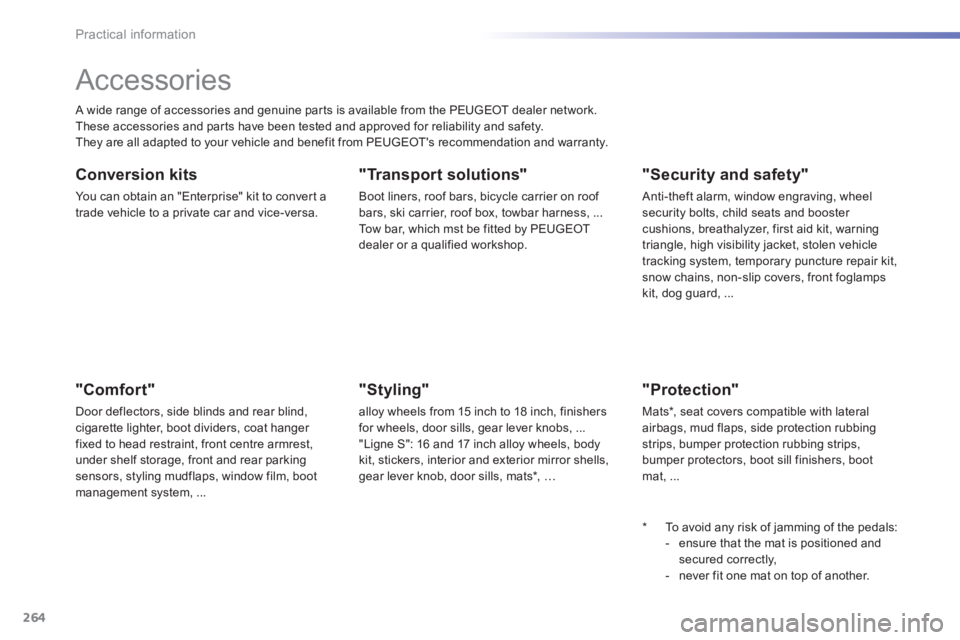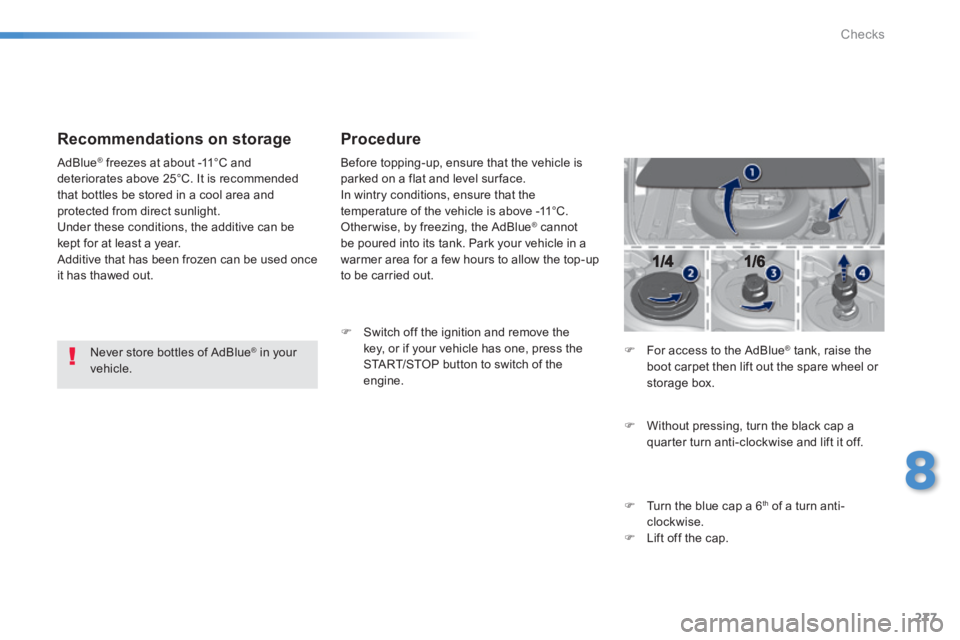Page 233 of 400
231
7
Practical information
308_EN_CHAP07_INFO PR ATIQUES_ED02-2013
Position the foot of the jack on the ground, ensuring that it is directly below the jacking point A or B used.
Raise the vehicle until there is sufficient space between the wheel and the ground to admit the spare (not punctured) wheel easily. Remove the bolts and store them in a clean place. Remove the wheel.
Extend the jack 2 until its head comes into contact with A or B (the head of the jack positioned centrally on contact sur face of the jacking point on the body).
Page 234 of 400
232
Practical information
308_EN_CHAP07_INFO PR ATIQUES_ED02-2013
Fitting a wheel
Fitting the "space-saver" spare wheel
If your vehicle is fitted with alloy wheels, when tightening the bolts on fitting, it is normal to notice that the washers do not come into contact with the "space-saver" spare wheel. The wheel is secured by the conical sur face of each bolt.
List of operations
Put the wheel in place on the hub. Screw in the bolts fully by hand. Pre-tighten the security bolt using the wheelbrace 1 fitted with the security socket 4 (according to equipment). Pre-tighten the other bolts using the
wheelbrace 1 o n l y.
Lower the vehicle fully. Fold the jack 2 and detach it.
Page 235 of 400
233
7
Practical information
308_EN_CHAP07_INFO PR ATIQUES_ED02-2013
Tighten the security bolt using the wheelbrace 1 fitted with the security socket 4 (according to equipment). Tighten the other bolts using the wheelbrace 1 o n l y. Refit the bolt covers on each of the bolts
(according to equipment). Store the tools in the box.
The tyre inflation pressures are given on this label.
After changing a wheel
To store the punctured wheel in the boot correctly, first remove the central cover. When using the "space-saver" type spare wheel, do not exceed 50 mph
(80 km/h). Have the tightening of the bolts and the pressure of the spare wheel checked by a PEUGEOT dealer or a qualified workshop without delay. Have the punctured wheel repaired and refitted to the vehicle as soon as possible. If your vehicle has tyre under-inflation detection, check the tyre pressures then refer to the corresponding section.
Page 236 of 400

234
Practical information
308_EN_CHAP07_INFO PR ATIQUES_ED02-2013
Snow chains
In wintry conditions, snow chains improve traction as well as the behaviour of the vehicle when braking.
The snow chains must be fitted only to the front wheels. They must never be fitted to "space-saver" type spare wheels.
Take account of the legislation in force in your country on the use of snow chains and the maximum running speed authorised.
Avoid driving on roads that have been cleared of snow, to avoid damaging your vehicle's tyres and the road sur face. It is recommended that before you leave, you practise fitting the snow chains on a level and dry sur face. If your vehicle is fitted with alloy wheels, check that no part of the chain or its fixings is in contact with the wheel rim.
Use only the chains designed to be fitted to the type of wheel fitted to your vehicle:
You can also use non-slip tyre covers. For more information on snow chains, contact a PEUGEOT dealer or a qualified workshop.
Advice on installation
If you have to fit the chains during a journey, stop the vehicle on a flat sur face on the side of the road. Apply the parking brake and position any wheel chocks to prevent movement of your vehicle. Fit the chains following the instructions provided by the manufacturer. Move off gently and drive for a few moments, without exceeding 30 mph (50 km/h). Stop your vehicle and check that the snow chains are correctly tightened.
Original tyre size Type of chain.
195/65 R15
9 mm links 205/55 R16
225/45 R17
225/40 R18 K-Summit K23
Page 260 of 400

258
Practical information
308_EN_CHAP07_INFO PR ATIQUES_ED02-2013
General recommendations
Observe the legislation in force in your country. Ensure that the weight of the towing vehicle is higher than that of the towed vehicle. The driver must remain at the wheel of the towed vehicle and must have a valid driving licence. When towing a vehicle with all four wheels on the ground, always use an approved towing bar; rope and straps are prohibited. The towing vehicle must move off gently. When towing a vehicle with the engine off, there is no longer any power assistance for braking or steering. In the following cases, you must always call on a professional recovery service: - vehicle broken down on a motor way or fast road, - four-wheel drive vehicle, - when it is not possible to put the gearbox into neutral, unlock the steering, or release the parking brake, - towing with only two wheels on the ground, - where there is no approved towing bar available...
On the rear bumper, press the cover (as shown above) to unclip it. Screw the towing eye in fully. Install the towing bar. Switch on the hazard warning lamps on the towed vehicle. Move off gently and drive slowly over a short distance only.
From the rear
Page 266 of 400

264
Practical information
308_EN_CHAP07_INFO PR ATIQUES_ED02-2013
Accessories
A wide range of accessories and genuine parts is available from the PEUGEOT dealer network. These accessories and parts have been tested and approved for reliability and safety. They are all adapted to your vehicle and benefit from PEUGEOT's recommendation and warranty.
"Comfort"
Door deflectors, side blinds and rear blind, cigarette lighter, boot dividers, coat hanger
fixed to head restraint, front centre armrest, under shelf storage, front and rear parking sensors, styling mudflaps, window film, boot management system, ...
"Transport solutions"
Boot liners, roof bars, bicycle carrier on roof bars, ski carrier, roof box, towbar harness, ...
Tow bar, which mst be fitted by PEUGEOT dealer or a qualified workshop.
"Styling"
alloy wheels from 15 inch to 18 inch, finishers for wheels, door sills, gear lever knobs, ... "Ligne S": 16 and 17 inch alloy wheels, body kit, stickers, interior and exterior mirror shells, gear lever knob, door sills, mats * , …
* To avoid any risk of jamming of the pedals: - ensure that the mat is positioned and secured correctly, - never fit one mat on top of another.
"Security and safety"
Anti-theft alarm, window engraving, wheel security bolts, child seats and booster
cushions, breathalyzer, first aid kit, warning triangle, high visibility jacket, stolen vehicle tracking system, temporary puncture repair kit, snow chains, non-slip covers, front foglamps kit, dog guard, ...
"Protection"
Mats * , seat covers compatible with lateral airbags, mud flaps, side protection rubbing strips, bumper protection rubbing strips, bumper protectors, boot sill finishers, boot mat, ...
Conversion kits
You can obtain an "Enterprise" kit to convert a trade vehicle to a private car and vice-versa.
Page 279 of 400

277
8
Checks
308_EN_CHAP08_VERIFICATIONS_ED02-2013
Recommendations on storage
Never store bottles of AdBlue ® in your ® in your ®
vehicle.
AdBlue ® freezes at about -11°C and ® freezes at about -11°C and ®
deteriorates above 25°C. It is recommended that bottles be stored in a cool area and protected from direct sunlight. Under these conditions, the additive can be kept for at least a year. Additive that has been frozen can be used once it has thawed out.
Procedure
Before topping-up, ensure that the vehicle is parked on a flat and level sur face. In wintry conditions, ensure that the temperature of the vehicle is above -11°C.
Otherwise, by freezing, the AdBlue ® cannot ® cannot ®
be poured into its tank. Park your vehicle in a warmer area for a few hours to allow the top-up to be carried out.
Switch off the ignition and remove the key, or if your vehicle has one, press the START/STOP button to switch of the engine.
For access to the AdBlue ® tank, raise the ® tank, raise the ®
boot carpet then lift out the spare wheel or storage box.
Without pressing, turn the black cap a quarter turn anti-clockwise and lift it off.
Turn the blue cap a 6 th of a turn anti-clockwise. Lift off the cap.
Page 289 of 400

287
9
Technical data
308_EN_CHAP09_CARACTERISTIQUES TECHNIQUES_ED02-2013
Identifi cation markings Various visible markings for the identification of your vehicle.
A. Vehicle Identification Number (VIN) under the bonnet. This number is engraved on the chassis near the right hand front wheel arch.
The tyre pressures must be checked when the tyres are cold, at least once a month.
If the tyre pressures are too low, this
increases fuel consumption.
B. Vehicle Identification Number (VIN) on the windscreen lower cross member. This number is indicated on a self-adhesive label which is visible through the windscreen.
C. Manufacturer's label. This self-destroying label affixed to the centre pillar, right or left hand side, contains the following information. - the manufacturer's name, - the European whole vehicle type approval number, - the vehicle identification number (VIN), - the maximum authorised weight (gross vehicle weight), - the maximum authorised weight with trailer (gross train weight), - the maximum front axle weight, - the maximum rear axle weight.
D. Tyre/paint label. This label, affixed to the centre pillar, on the driver's side, contains the following information. - the tyre inflation pressures with and without load, - the tyre sizes (including the tyre load index and speed rating), - the inflation pressure for the spare wheel, - the paint colour code.